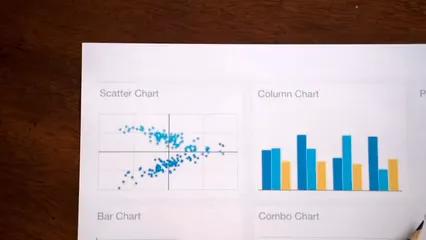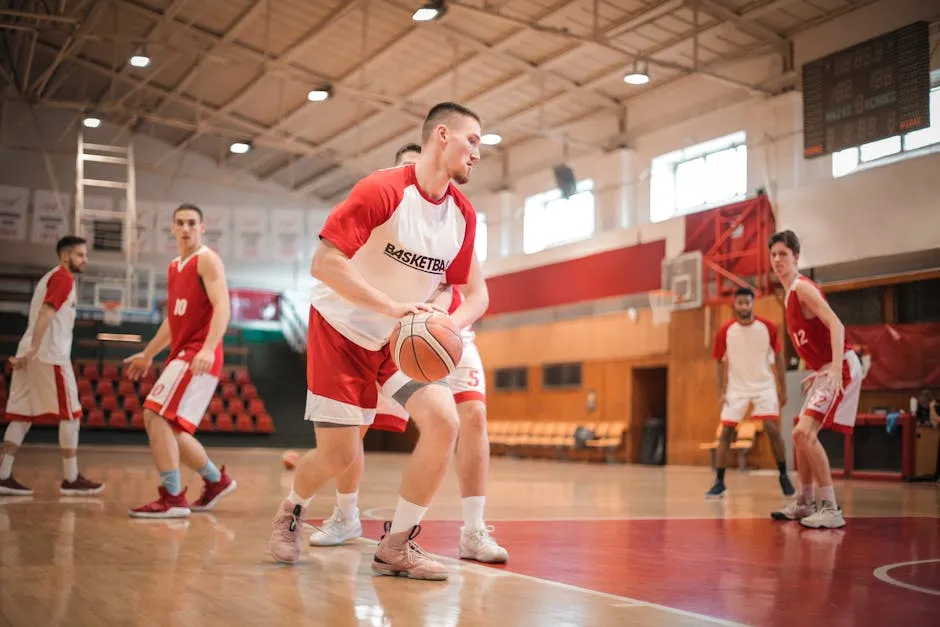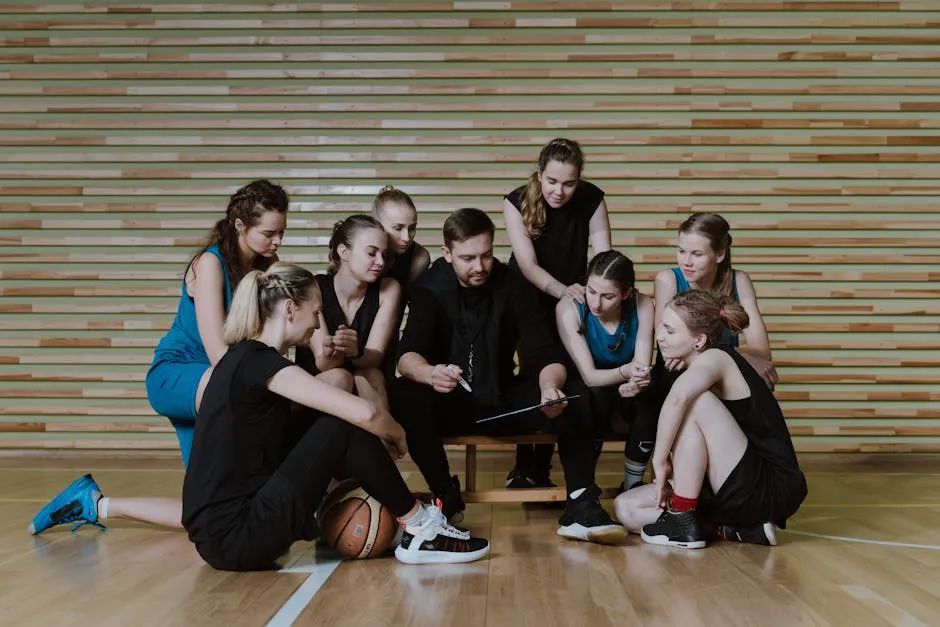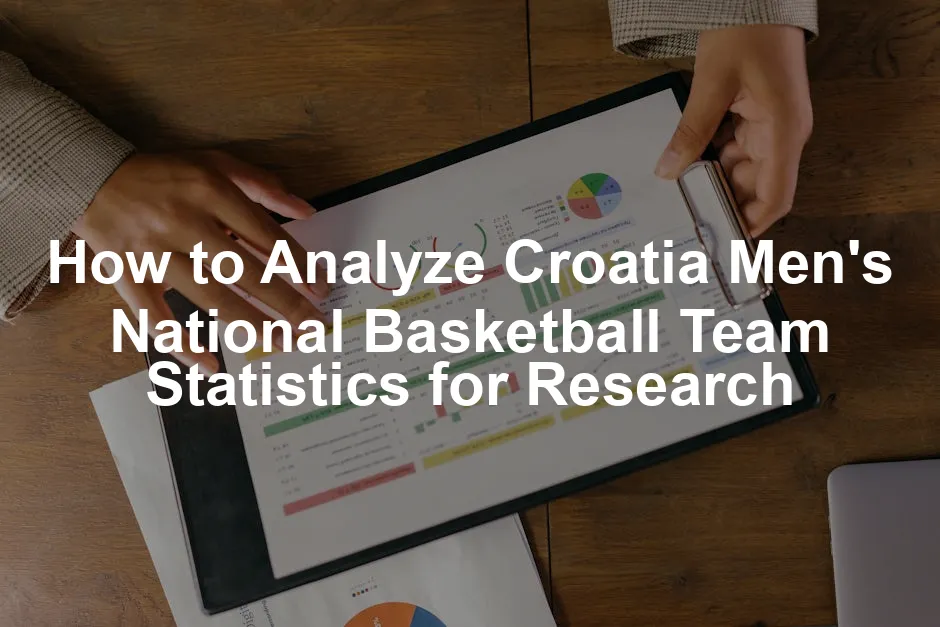Introduction
In the realm of basketball analytics, numbers reveal stories that shape teams’ futures. For the Croatia Men’s National Basketball Team, analyzing performance statistics is more than just a research task. It’s essential for enriching strategy, enhancing player development, and informing decision-making. This article outlines effective methods to analyze these statistics, providing valuable insights for researchers, coaches, and basketball fans.
With a healthy mix of historical data, current trends, and innovative analytical techniques, uncover the keys to Croatia’s basketball achievements. Whether you’re a coach looking to refine strategies or a fan wanting to understand team dynamics, this guide will help you make sense of the stats. The basketball court may seem like chaos, but behind the scenes, there’s a method to the madness.
Armed with the right approach, you can dissect performance indicators like a seasoned analyst. From points per game to shooting efficiency, each number contributes to the larger narrative of success. This guide aims to elevate your research game, arming you with the tools to uncover insights that can lead to breakthroughs on and off the court. So, gear up! It’s time to transform raw data into actionable intelligence that shines a light on Croatia’s basketball prowess.
Speaking of tools, if you’re serious about improving your game, consider investing in a Basketball Training Equipment Set. With essential tools for dribbling, shooting, and agility, you can elevate your skills and impress your coach. Plus, who doesn’t want to be the star of the next pickup game?

Summary of Key Points
- Understanding the Importance of Statistics: Basketball statistics are crucial for assessing performance, shaping team strategy, and evaluating player skills.
- Key Performance Indicators (KPIs): Essential KPIs include points per game, shooting percentages, rebounds, assists, and defensive metrics that define the Croatian team’s success.
- Situational Efficiency Parameters: Learn how situational efficiency parameters, drawn from various studies, can accurately gauge the team’s performance.
- Statistical Tools and Methods: Explore tools and methodologies used in sports statistics analysis, such as regression analysis and performance indices.
- Trends and Historical Context: Analyze the evolution of the Croatian basketball team’s performance using historical data for a comprehensive view.
- Practical Applications: Discover how these analyses can guide coaching strategies, player selection, and enhance overall team performance.

The Role of Statistics in Basketball
Overview of Basketball Analytics
In today’s basketball landscape, data isn’t just a sidekick; it’s the star of the show. Teams across the globe, including the NBA and international competitions, have embraced analytics to refine their strategies and enhance player performance. For instance, the Golden State Warriors transformed their game by focusing on three-point shooting efficiency. This approach revolutionized not just their playing style but also how teams evaluate talent.
Similarly, international teams leverage statistics to gain an edge. They analyze player performance in various situations, such as clutch moments in high-stakes games. Croatia’s national team, for example, has utilized data analysis to identify key players who shine under pressure, effectively informing their game plans. This data-driven mindset has become crucial in modern basketball, influencing everything from training regimens to in-game tactics.

For those who want to keep track of their own performance, a Performance Tracker Smartwatch can be a game-changer. With features that monitor your heart rate, track your workouts, and even analyze your shooting patterns, this gadget will help you take your game to the next level—just make sure to wear it while you’re doing those three-point drills!
Commonly Used Statistics
Statistics in basketball can be as diverse as the players on the court. Basic stats like points, assists, and rebounds are the foundation of performance analysis. Points scored, of course, are the ultimate goal. But how players contribute to these points tells a deeper story.
Assists measure teamwork and playmaking ability. A player with high assist numbers is often a facilitator, creating opportunities for teammates. Meanwhile, rebounds reflect a player’s ability to control the game, both offensively and defensively. Offensive rebounds give teams second chances, while defensive rebounds prevent the opponent from scoring.
Beyond these basics, advanced metrics have emerged, providing an even clearer picture. For example, Player Efficiency Rating (PER) combines several statistics into a single value, capturing a player’s overall contribution. Similarly, Effective Field Goal Percentage (eFG%) accounts for the extra value of three-pointers, offering insights into shooting efficiency.

While basic statistics serve as a good starting point, combining them with advanced metrics can yield a more comprehensive understanding of a player’s impact on the court. This multifaceted approach is essential for teams like Croatia, where every point and assist can change the course of a game.
Analyzing Key Performance Indicators
Points per Game (PPG)
When analyzing the scoring prowess of the Croatia Men’s National Basketball Team, Points per Game (PPG) is a vital metric. PPG provides a straightforward overview of a player’s scoring ability. However, understanding how this number is achieved is equally critical.
Two-point and three-point shooting percentages play significant roles in overall scoring efficiency. For instance, if a player averages 20 PPG but relies heavily on three-point attempts, their shooting percentage can offer deeper insights. A player hitting 40% from beyond the arc is contributing more valuable points than one scoring the same average while shooting just 30% from two-point range.
Additionally, examining shot selection is crucial. Are players taking high-percentage shots, or are they forcing difficult attempts? Teams can improve their PPG by encouraging smarter shot selection, focusing on high-quality looks instead of volume shooting.

To help with shot selection, a Basketball Shooting Training Aid can be a fantastic investment. This tool helps players develop their shooting form and consistency, ensuring that when it’s time to shoot, you’re not just winging it. After all, nobody wants to be known as the player who can’t hit the broad side of a barn!
Rebounding and Assists
Rebounding is another cornerstone of basketball performance. The distinction between offensive and defensive rebounds is pivotal. Offensive rebounds create additional scoring opportunities, while defensive rebounds signify effective defense and transition control. Croatia’s performance can significantly improve by focusing on securing rebounds, especially against teams with strong inside presence.
Assist-to-Turnover ratios also provide insights into a player’s efficiency and decision-making. A higher ratio indicates that a player is making smart plays, contributing to the team’s scoring while minimizing mistakes. This metric is particularly valuable for guards, who often handle the ball and set up plays.

Defensive Metrics
Defense wins games! In basketball, this saying rings especially true. Defensive metrics, such as steals and blocks, are critical in assessing a team’s defensive strength. Steals can lead to fast-break opportunities, shifting momentum in favor of the defensive team. Tracking steals can highlight players who excel in creating turnovers and capitalizing on them.
Blocks, on the other hand, showcase a player’s ability to protect the rim. A player who averages multiple blocks per game can instill fear in opponents, altering their shot selection. Defensive rebounds also play a crucial role, as they prevent second-chance points and allow the team to control the pace of the game.
Collectively, these defensive metrics not only reflect individual prowess but also indicate team cohesion on defense. For the Croatia Men’s National Basketball Team, understanding these key performance indicators can lead to strategic adjustments that enhance both offensive and defensive efficiencies.

Situational Efficiency Parameters
Understanding Situational Efficiency
Situational efficiency refers to how well players perform under specific game conditions. This concept is crucial in predicting game outcomes. It highlights the importance of various situational factors like shot selection, defensive pressure, and game tempo. By analyzing these elements, coaches can gauge how a player’s performance might change in different contexts, such as during high-stakes moments or against tougher opponents.
Understanding situational efficiency helps teams make informed decisions. Coaches can tailor strategies, focusing on players who excel in critical situations. For instance, if a player demonstrates high efficiency during pressure-packed moments, they can be given the ball more often when the game is on the line. This information can be the difference between a win and a loss.

And if you want to keep your cool under pressure, you might want to check out a Sports Massage Gun. This little gadget is perfect for relieving muscle tension and soreness, helping you recover faster and perform better when it matters most—because nobody wants to be that guy who’s too sore to play in the final quarter!
Case Studies
One noteworthy study is by Josko Sindik, who researched situational efficiency parameters among top Croatian basketball players. His findings revealed a robust correlation between situational efficiency variables and overall shot percentage during matches. By analyzing 29 games played by KK Budućnost in the 2017/18 ABA League season, Sindik discovered that these parameters could predict shot effectiveness with nearly 100% accuracy.
Sindik’s work emphasized that situational efficiency isn’t just about raw numbers. It considers the context of each play. For example, a player’s shooting percentage might dip under tight defense, but their situational efficiency could remain high if they consistently create quality shot opportunities. This nuanced understanding of player performance is vital for crafting effective game plans tailored to individual strengths.

Application of Findings
The insights gained from studying situational efficiency parameters can dramatically influence coaching techniques and player training. Coaches can use this data to develop targeted drills that replicate high-pressure scenarios. By doing so, players can practice their responses to similar conditions they might face in actual games.
For example, if data shows that a player struggles under fatigue, coaches can simulate late-game fatigue in practice. This approach helps players develop strategies to maintain composure and performance levels when the stakes are high. Additionally, training sessions can be adjusted based on individual situational efficiency metrics. A player who performs well under pressure can be entrusted with more responsibilities during crucial game moments.
Moreover, understanding situational efficiency helps in player selection. Coaches can identify which players thrive in specific situations, allowing for more strategic substitutions. This data-driven approach enhances overall team performance by ensuring the right players are on the court at critical times.
In summary, situational efficiency parameters are essential for analyzing and improving the Croatia Men’s National Basketball Team’s performance. By understanding and applying these concepts, coaches can refine strategies, enhance player development, and ultimately increase the likelihood of success on the court.

Statistical Tools and Methodologies
Regression Analysis
Regression analysis is a powerful statistical tool used in basketball analytics. It helps in understanding relationships between various performance metrics and game outcomes. By employing regression models, analysts can pinpoint which factors most significantly influence a team’s success.
In basketball, multiple regression models can analyze how different variables—like rebounds, assists, and shooting percentages—interact. For example, a model might reveal that while points scored are essential, a player’s assist-to-turnover ratio could be a more significant predictor of winning. This insight allows coaches to emphasize certain skills in practice, enhancing overall team effectiveness.

Performance Indices
Performance indices provide a comprehensive view of player efficiency. These indices sum up various statistics into a single value, allowing for quick comparisons. One well-known index is the Player Efficiency Rating (PER), which combines points, rebounds, assists, and more to gauge a player’s overall contribution.
Calculating performance indices involves gathering data from multiple games and applying formulas that weigh each statistic according to its importance in determining a player’s impact. For instance, shooting efficiency might have a higher weight than turnovers in some contexts. By analyzing these indices, coaches can make informed decisions about player rotations, matchups, and game strategies.
In conclusion, both regression analysis and performance indices are invaluable in analyzing the Croatia Men’s National Basketball Team’s statistics. These methodologies not only clarify how individual performances translate to team success but also guide strategic coaching decisions. By leveraging these tools, teams can better understand their strengths and weaknesses, ultimately leading to improved performance on the court.

Historical Trends and Performance Analysis
Evolution of Croatian Basketball
Croatian basketball is a storied tradition, rich with achievements and memorable moments. The national team burst onto the international scene in the 1990s, following the breakup of Yugoslavia. One of their crowning achievements came in 1992 when they clinched the bronze medal at the Barcelona Olympics. This success was not just a flash in the pan; it set the tone for future tournaments.
Throughout the years, Croatia has consistently showcased its talent. They finished as the runners-up in the 1990 FIBA World Championship and again in the 1992 Olympics. The 1995 EuroBasket saw them triumph, solidifying their status as a European powerhouse. The statistics tell a compelling tale: Croatia has competed in every major tournament since its independence, often reaching the later stages, proving they belong among the elite.
Statistics from these tournaments reveal an impressive average of 80 points per game during peak performances, with shooting percentages that frequently eclipsed 50% from the field. Players like Dražen Petrović and Toni Kukoč became household names, their individual stats often highlighting their scoring prowess and playmaking abilities. These achievements laid the groundwork for the next generation of Croatian basketball.

Recent Performance Metrics
Fast forward to the present, and the Croatian national team continues to adapt and evolve. Recent performance metrics showcase a blend of experience and youth. The team has seen fluctuations in success but remains competitive on the international stage. Statistical insights from their last few tournaments reveal a few patterns worth noting.
In the 2023 EuroBasket, Croatia averaged 76 points per game, with a shooting percentage hovering around 47%. This marked a slight dip from their historical averages but showcased the team’s resilience. Key player performances, particularly from stars like Ivica Zubac, who averaged 22.8 points and 11.3 rebounds in recent qualifiers, highlight the potential for growth. Notably, Zubac’s efficiency in the paint has become a focal point for the team’s strategy.
Analyzing team dynamics, the assist-to-turnover ratio has improved, indicating better ball movement and decision-making under pressure. Recent matches display a tendency for the team to rely on a three-point shooting strategy, reflecting broader trends in basketball. The Croatian squad has incorporated advanced analytics into their game preparation, focusing on maximizing shooting opportunities beyond the arc.
Moreover, defensive metrics reveal that Croatia has improved its rebounding, averaging 36 rebounds per game, which is crucial for controlling tempo and second-chance points. This commitment to rebounding manifests in their ability to transition quickly from defense to offense, an essential aspect of modern basketball strategy.

Practical Applications of Statistical Analysis
Coaching Strategies
Statistical analysis is a game-changer for coaches. By leveraging data, they can craft strategies that maximize their team’s strengths. For the Croatian national team, this means tailoring game plans based on statistical insights from previous matches. Coaches can identify which players excel in specific situations, such as clutch moments or against particular opponents.
Utilizing metrics like effective field goal percentage and assist ratios, coaches can design drills that focus on improving these areas. For instance, if data shows that a player has a high shooting percentage from the corner three-point line, plays can be structured to create those opportunities during games. This data-driven approach fosters a more strategic mindset, enabling coaches to make informed decisions on rotations, matchups, and game tactics.

Player Development
Statistics are invaluable for player development. By analyzing individual performance metrics, coaches can pinpoint areas for improvement. For example, if a player’s free throw percentage is below average, targeted training can be implemented to enhance that skill. This tailored approach helps players work on their weaknesses while also leveraging their strengths.
Furthermore, tracking situational efficiency parameters allows coaches to assess how players perform under pressure. Understanding a player’s tendency to excel in clutch situations can determine their roles in late-game scenarios. By focusing on these statistics, coaches can create personalized development plans, ultimately leading to a more skilled and versatile roster.
In conclusion, the integration of statistical analysis into coaching strategies and player development processes is essential for the Croatian Men’s National Basketball Team. By embracing data, they not only honor their rich history but also pave the way for future success on the international stage.
Conclusion
Analyzing the statistics of the Croatia Men’s National Basketball Team reveals crucial insights that can significantly enhance both performance and understanding of the game. The data-driven approach underscores the importance of metrics such as points per game, assists, rebounds, and shooting percentages. By scrutinizing these statistics, coaches can identify strengths and weaknesses, which can inform practice strategies and game plans.
One key takeaway is the value of situational efficiency parameters. These metrics help gauge how players perform under specific conditions, such as high-pressure situations. Understanding these dynamics is vital for making strategic decisions during critical moments in games. For instance, if a player excels in clutch situations, coaches can structure plays to exploit this advantage. Such insights can transform the outcomes of tightly contested matches.
Moreover, the ongoing evolution of basketball analytics cannot be overlooked. With advancements in technology and data collection methods, teams now have access to a wealth of information. This data can illuminate trends in player performance over time. For example, tracking shooting efficiency across different game contexts provides a more nuanced view of a player’s capabilities. As basketball continues to embrace analytics, staying updated with the latest methodologies will be essential for coaches and analysts alike.
Encouragingly, this analytical mindset can be applied not only in research but also in coaching practices. Coaches at all levels can benefit from incorporating statistics into their training regimens. By doing so, they can foster a culture of continuous improvement and adaptability. This approach not only enhances individual player development but also contributes to overall team success.
In summary, the insights derived from analyzing the Croatia Men’s National Basketball Team statistics highlight the critical role of data in modern basketball. This analytical framework not only aids in improving performance but also enriches the understanding of the game itself. As basketball analytics continue to evolve, embracing these techniques will empower coaches and researchers alike to unlock new levels of success.
FAQs
What are the most important statistics to analyze for a basketball team?
Key statistics to consider include points per game (PPG), shooting percentages, rebounds, assists, and defensive metrics. These figures provide a comprehensive view of a team’s performance and can indicate areas for improvement. Advanced metrics like Player Efficiency Rating (PER) and true shooting percentage also offer deeper insights into player contributions.
How can I access detailed statistics for the Croatian Men’s National Basketball Team?
Comprehensive statistics can be accessed through various sports databases and official league websites. Resources like FIBA’s official site, Proballers, and basketball-reference.com provide in-depth statistics and historical performance data for the Croatian national team.
What statistical tools are recommended for basketball analysis?
Popular tools for basketball analysis include Excel for data management, R and Python for statistical modeling, and specialized software like Synergy Sports and SportsCode for in-depth game analysis. These tools help coaches and analysts visualize data and derive actionable insights.
How does situational efficiency differ from regular performance metrics?
Situational efficiency specifically measures a player’s performance in various game contexts, such as clutch plays or against specific defenses. In contrast, regular performance metrics provide an overall view of a player’s contributions without accounting for the context of each play. Understanding situational efficiency helps coaches adjust strategies during games.
Can this analysis be applied to other sports?
Absolutely! The analytical methods used for basketball statistics can be applied across various sports. Metrics like player efficiency, situational performance, and team dynamics are relevant in sports such as soccer, football, and baseball. By adapting these techniques, coaches and analysts can enhance performance across disciplines.
Please let us know what you think about our content by leaving a comment down below!
Thank you for reading till here 🙂
For those interested in a deeper understanding of statistical learning in basketball, consider checking out an introduction to statistical learning with python book length.
And if you’re a fan of basketball literature, don’t miss out on “The Book of Basketball: The NBA According to the Sports Guy” by Bill Simmons. It’s a must-read for anyone wanting to dive deeper into the world of basketball and its statistics. You’ll laugh, you’ll cry, and you’ll definitely learn something!
All images from Pexels




